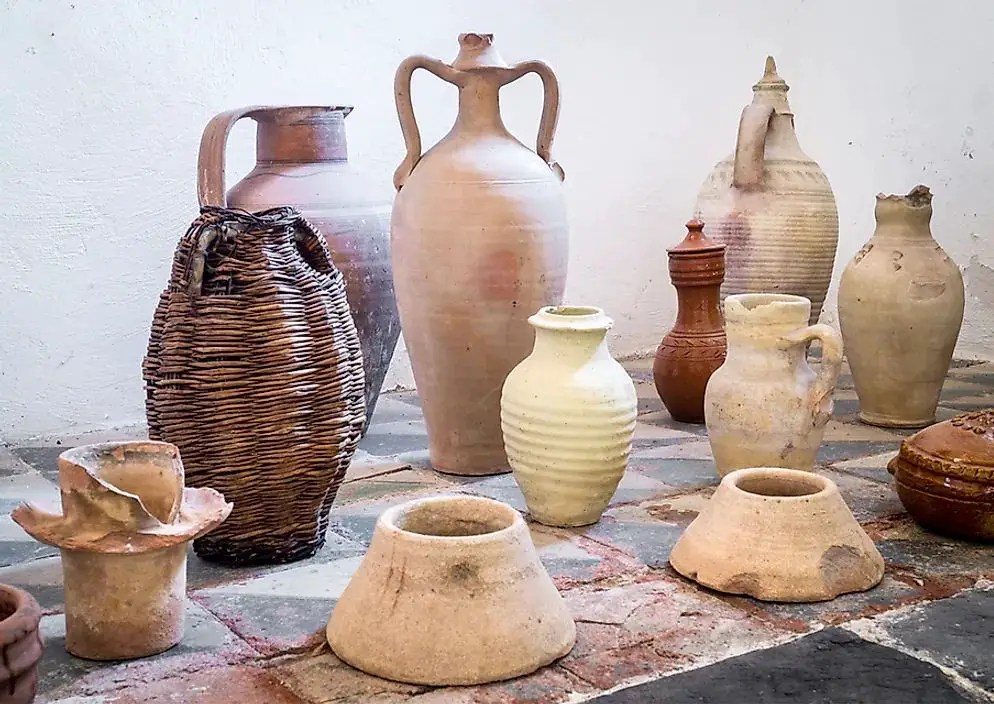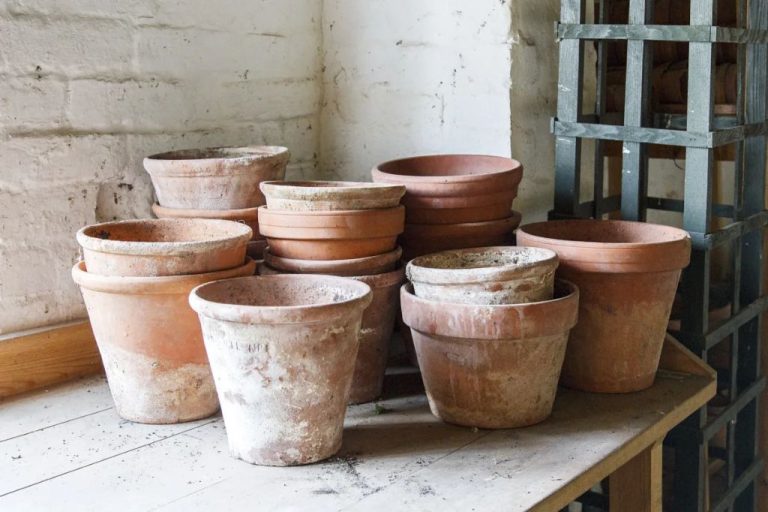What Terra Cotta Literally Means?
Terra cotta literally translates to “baked earth” in Italian. It refers to clay-based ceramics that have been shaped and then fired at high temperatures to harden the material. Terra cotta has been used for thousands of years to create pottery, sculpture, roof tiles, and other architectural elements. In this article, we will examine the literal meaning and origins of the term “terra cotta.” We’ll look at the etymology of the individual words “terra” and “cotta,” learn about the history of terra cotta, its common uses, how it is produced today, and more.
Etymology of Terra Cotta
The term “terra cotta” comes from Italian and literally means “cooked earth.” It is a combination of two Italian words:
- “Terra” meaning “earth” or “soil.” This derives from the Latin word “terra” and further back to the Proto-Indo-European root “*ters-” meaning “to dry.”
- “Cotta” meaning “cooked” or “baked.” This comes from the Latin verb “coquere” meaning “to cook.”
So when the two words are combined, “terra cotta” refers to clay from the earth that has been cooked or baked to harden it.
The first recorded use of the Italian phrase “terra cotta” was around the 1540s, referring specifically to pottery and ceramic wares made from clay and baked at high temperatures.
The etymology underscores how terra cotta starts from the earth itself, dirt and clay, which is then transformed through heat into a durable, permanent material ideal for vessels, sculptures, bricks, tiles, and more. While earthenware refers to any clay hardened through firing, “terra cotta” specifies it is made from clay sourced directly from the earth.
Meaning of ‘Terra’
The word ‘terra’ comes from Latin and means ‘earth’ or ‘land’. According to Wiktionary, https://en.wiktionary.org/wiki/Terra, ‘terra’ was the name for the Roman goddess of the Earth. It was also used as an alternate name for the planet Earth itself. In Latin, ‘terra’ refers to the ground or land of the Earth’s surface.
‘Terra’ maintains this meaning in modern Italian as well, where it continues to mean ‘earth’, ‘ground’, or ‘land’. So the Latin and Italian meaning of the word ‘terra’ refers to the Earth itself or the ground/land of the Earth’s surface.
Meaning of ‘Cotta’
‘Cotta’ comes from the Italian word for ‘cooked’. In Italian, the word ‘cotto’ means ‘cooked, baked’. The past participle of ‘cuocere’, which means ‘to cook’, is ‘cotto’. So literally ‘cotta’ means ‘cooked earth’, referring to the clay or earthenware that has been fired or baked at high temperatures in a kiln. This baking process is key to creating the terra cotta material.
According to the Cambridge Dictionary, ‘cotta’ in Italian means “a piece of fired clay”. The Collins Dictionary also defines ‘cotta’ as meaning “baked clay”. So the origins of ‘cotta’ trace back to Italian words referring to cooking, baking, and fired or baked clay.
The two root words ‘terra’ meaning earth and ‘cotta’ meaning cooked come together to form ‘terra cotta’, literally translated as ‘cooked earth’.
Cooked Earth
The term “terra cotta” comes from a Latin phrase that literally translates to “cooked earth.” The word “terra” means “earth,” while “cotta” comes from the Latin word “coctus,” meaning “cooked” (Sources).
So when the two words are combined into “terra cotta,” the literal meaning is “cooked earth.” This name refers to the process used to create terra cotta, which involves mining clay from the earth, shaping it, and then firing or “cooking” it with high heat to harden and strengthen the material (Sources).
The firing process transforms the soft clay into a durable, ceramic material ideal for making pots, sculptures, roof tiles, and other objects. So terra cotta gets its name from the method of taking raw earth and clay, and cooking it into a new and useful substance.
Clay From the Earth
Terra cotta literally means “baked earth” in Italian. The term refers to clay that is dug up from the earth, shaped into various forms, and then fired at high temperatures in a kiln. This firing process hardens the clay through sintering, making it durable and water resistant.
The clay used to make terra cotta contains natural mineral impurities that give it its characteristic red-orange color after firing. It’s an earthenware clay that is usually mined locally where the terra cotta products are made. According to Rural Handmade, “Terracotta clay is typically sourced near the kilns used to fire the final products.”
Once the clay is extracted from clay beds or pits, it goes through a refining process to prepare it for shaping and firing. This involves removing stones and organic matter, weathering it through exposure to the air, and mixing it with water to achieve the desired smooth, workable consistency.
The clay is then hand shaped on a wheel or molded to create pots, sculptures, bricks, tiles, and various other useful and decorative objects. These pieces are dried slowly to remove the moisture before being loaded into the kiln and fired at temperatures ranging from 1562°F to 2102°F, which causes the clay to permanently harden into terra cotta.
History of Terra Cotta

Terra cotta has been in use for thousands of years and found in many ancient societies. The earliest known use dates back to around 30,000 BC in dolni vestonice in the Czech Republic where small statues of Venus figurines were made from fired clay.
In ancient China, terra cotta was used extensively for pottery and figurines. The most famous example is the Terracotta Army built for the first emperor of China, Qin Shi Huang, around 210-209 BC to guard his tomb. It consists of over 8,000 life-size terra cotta soldiers, horses, and chariots. The figures were made by pressing clay into molds and then firing the clay to harden it. The army was buried with the emperor and not discovered again until 1974.
Ancient Greeks and Romans also used terra cotta for pottery, roof tiles, and decorative figures. Many terra cotta figures and reliefs have been found from these cultures. The Romans used it for drainage pipes, bricks, and linings for aqueducts.
Terra cotta continued to be important through the Middle Ages and Renaissance for both practical and decorative purposes. Italian sculptors like the Della Robbia family created elaborate glazed terra cotta reliefs and sculptures in the 15th and 16th centuries.
So in summary, terra cotta was one of the earliest and most widely used materials for pottery, sculpture, and construction due to its availability, workability, and durability when fired. Major ancient civilizations utilized terra cotta for both practical objects and decorative art.
Terra Cotta Uses
Terra cotta has been used for architectural and decorative purposes for thousands of years. Some of the main uses of terra cotta include:
Architectural Elements – Terra cotta is ideal for architectural elements like decorative facades, cornices, columns, balustrades, roof tiles, chimney pots, and more. The durability and moldability of terra cotta allows it to be shaped into elaborate decorative details. Terra cotta provides both aesthetic appeal and protection from weathering. Famous examples of architectural terra cotta can be seen on buildings like the Woolworth Building in New York City.
Sculpture – The clay properties of terra cotta have made it a popular medium for sculpture since ancient times. Terra cotta can be molded into detailed shapes and fired to create durable sculptural works. From ancient Greek Tanagra figurines to medieval Spanish relief sculpture to modern terra cotta works, sculpture has been a key use of this material. Terra cotta sculpture can be found decorating buildings, in museum collections, and in public art installations.
Some important considerations for working with terra cotta sculpture include the need to limit overhangs and projections which can break if too thin. Knowing the properties and shrinkage rate of the clay body is also important when designing terra cotta sculpture. Overall, terra cotta allows sculptors great freedom to shape detailed, custom works in clay.
Terra Cotta Production Today
Terra cotta is still widely produced today using modern manufacturing techniques. The basic process involves mining clay, refining it, mixing it, molding it into shapes, drying it, and firing it in a kiln.
Clay is mined from quarries or pits, usually near the manufacturing facility to reduce transportation costs. The clay is then refined to remove impurities like gravel, roots, and organic material. It is then mixed with water to reach an optimal consistency for shaping.
Next, the terra cotta clay is molded into the desired shapes and designs using techniques like throwing on a pottery wheel, slipcasting in plaster molds, or extruding through dies. The molded pieces are air-dried over several days until firm enough to handle.
Finally, the dried terra cotta pieces are fired in large gas or electric kilns at high temperatures between 1000-1200°C. This hardens the clay through sintering and crystallization processes. The final fired terra cotta has an earthy red-brown color and slightly porous texture.[1]
Automation and computer-aided design have increased efficiency and design capabilities for modern terra cotta manufacturing. However, the fundamentals of working with natural clays remain largely the same as past centuries.
Conclusion
In summary, the literal meaning of the term “terra cotta” comes from Latin. “Terra” means “earth” and “cotta” means “cooked”. When combined, these two words literally translate to “cooked earth”. This refers to the process of shaping clay from the earth and firing or “cooking” it to harden and finish the terra cotta material. Although terra cotta has an ancient history spanning thousands of years, it is still popular today for uses ranging from pottery to architecture. The meaning behind its name articulates the fundamental nature of this material as clay from the earth that is transformed through heat. When we call something “terra cotta”, we are literally describing it as cooked or baked earth.

